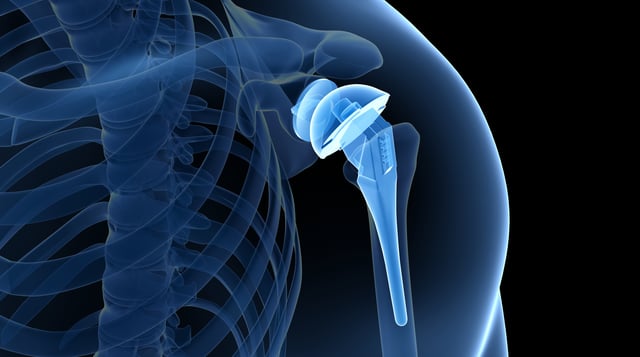Expanded indications along with new implants and technologies driving strong market growth 
Shoulder Market Outlook
Shoulder replacement has moved well beyond its days as an end-stage treatment for rheumatoid and osteoarthritis patients suffering from degenerative shoulder disease or for those with proximal humeral fractures. Since reverse shoulders hit the US market in 2003, their popularity has increased as a treatment option for OA and severe rotator cuff arthropathy, driving strong growth in this extremities market segment.
Today, anatomic shoulder implants are the most widely used shoulder prosthesis. Expanded indications for reverse shoulders along with new products and newer technologies such as short-stem shoulders will propel revenues to over $1B in 2020.
Post-2015 Merger Landscape
After the Zimmer Biomet and Wright Tornier mergers, the top players in the US Shoulder Market changed dramatically when looking at combined market shares for the year. Zimmer Biomet is clearly in the No. 1 player with ~38.6% share for 2015, according to SmartTRAK Financial Dashboard FY2015 results. DePuy Synthes held onto the No. 2 position with 20.5% share, a decline from 21.3% the previous year. Wright Medical is solidly in 3rd place with 18.2% combined share. The addition of Tornier’s upper extremities line moved the Company into large market player status.
However, smaller market players such as Exactech, Integra and DJO Surgical, which have been and mostly likely will continue to produce above market share, are the ones to watch as they fight to steal share.
Anatomic Shoulders: Short-Stem Shoulders Have Potential to Expand the Market
Currently, anatomic shoulder replacements are used in more than 40% of US Shoulder Replacement procedures. At the end of 2015, this market segment reached over $300MM in annual revenues. Procedures, on the other hand, are expected to grow at 8.5% with declines in ASPs – projected at approximately -1.8% – tempering revenue growth.
However, newer technologies in anatomic shoulders hitting the US have the potential to expand the market to younger patients pushing this market even higher. Short stem shoulder implants (aka “stemless” shoulders) provide the benefits of a total shoulder but minimize bone removal and soft-tissue disruption. This make them a more attractive option for younger, more active patients that do not want to alter their lifestyle because of shoulder pain. Wright Medical is the first to market in the US with its Simpliciti ultra-short stem shoulder. The Company believes Simpliciti will help them gain share in the shoulder market by taking procedures from the total anatomic, hemi, and resurfacing market segments. DePuy Synthes and Exactech are developing stemless shoulder systems; and Arthrex and Zimmer Biomet have implants in IDE status that are already CE Marked in Europe.
Popularity of Reverse Shoulders: No Signs of Stopping
Reverse shoulders, originally used for low-demand older patients with rotator cuff arthropathy, have seen increasing popularity and a wider spectrum of indications. Pathologies treated now include acute proximal humerus fractures, rotator cuff tears without arthropathy, osteoarthritis, chronic dislocation, failed anatomic total shoulder replacement, tumor resection, and rheumatoid arthritis in older and younger patients.
BioMedGPS projects that by 2021, reverse shoulder arthroplasty will comprise over 40% of all US shoulder replacement procedures. With ASPs generally 35% higher than anatomic shoulder systems, the reverse shoulder market controlled over 50% of US Shoulder Market revenues in 2015. Going forward, this market segment is expected to reach grow at a 5-yr CAGR of more than 10%.
According to SmartTRAK Product Explorer, there are 14 Companies with a combined total of 25 reverse shoulders in the US market. Also, companies that have added shoulder components convertible from an anatomic to reverse configuration have benefitted from the intraoperative flexibility this brings to surgeons. Companies such as Zimmer Biomet with its convertible Comprehensive humeral stems and Wright with Aequalis Ascend Flex components have attributed “convertible” implants with helping to drive above market growth in Shoulders.
Newer Technologies Sustaining Growth
Assistive technologies such as patient specific instruments are gaining acceptance with Shoulder specialists. In addition to the clinical benefits to patients due to more accurately placed implants, this technology also provides an intriguing marketing message for hospitals and surgeons looking to differentiate themselves. Arthrex, DJO Surgical and Zimmer Biomet all offer shoulder PSI in the US.
Another technology with the potential to impact the US market is pyrocarbon shoulder components, which are exceptionally resistant to wear. In late 2015, Wright Medical initiated enrollment of patients into an IDE clinical study designed to evaluate safety and effectiveness of pyrocarbon humeral heads for partial shoulder replacement, according to the Company’s Q415 earnings call. The heads are designed to improve outcomes, reduce procedural costs, and may be more attractive for younger active patients. While it may be a few years before other technologies such as robotics become a factor in the Shoulder Replacement Market, those being introduced now should sustain continued strong growth for the near future.





.png)
